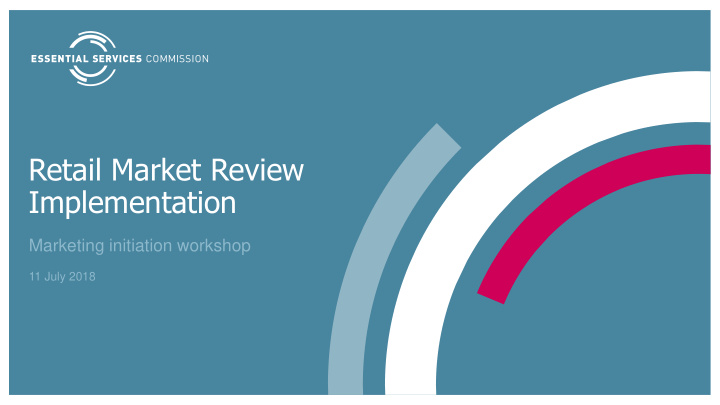



Retail Market Review Implementation Marketing initiation workshop 11 July 2018
Agenda Item Time Lead Welcome and introduction 5 mins Facilitator, ESC ‘Stocktake’ 10 mins Facilitator, All Update on recommendation 3 5 mins ESC Overview of 3A-3F 15 mins ESC Breakout discussions (with tea break) 60 mins All Report back 20 mins All Next steps and close 5 mins ESC 2
Stocktake
Update on recommendation 3
Recommendations 3 • Recommendation 3 contains eight sub-recommendations (3A-H) • The TOR require the commission to implement recommendation 3G first • Commission proposes to implement 3H at the same time as 3G • Current intention is to implement the remaining recommendations together (3A-F) 5
Working problem definition – bills and marketing stream Many Victorian customers are paying more than is necessary for their energy. This is in part due to the difficulty customers experience identifying the energy deal that best suits them. The difficulty that customers experience is related to the variety and complexity of the offers available in the market place, which include a range of benefits, fixed and variable charges, and unanchored discounts. In response to this complexity, even motivated customers appear to be reluctant to shop around. 6
Recommendations 3G (and 3H) 3G (‘best offer’ on bills) Five key questions • Scope • Meaning of ‘best offer’ • Presentation and design (supported by some consumer testing) • Frequency • Implementation and operational matters Consumer testing - update 3H (GST inclusive pricing) We plan to incorporate recommendation 3H into this draft decision. 7
Recommendations 3G (and 3H) (Cont) Anticipated timeframes • Draft decision – mid August 2018 • Submissions close – mid September 2018 • Final decision – October 2018 8
Overview of 3A-3F
Overview Recommendations 3A-F are a set of interlocking proposals primarily focused on improving the information available to customers via marketing channels and information disclosure tools. The improved information is intended to promote customer trust and confidence by making it easier to understand, compare and switch energy plans. 10
Approach Identify, for each recommendation • practical meaning • desired outcome • interactions between recommendations • key issues, risks, opportunities 11
Opportunities for stakeholder input • Today’s initiation workshop • Reference group meetings • 1-on-1 meetings • Draft decision (formal submissions) • Workshop on draft decision • Workshop on submissions to draft decision 12
For noting (today) – recommendations 3A, 3C and 3F Recommendation 3A Require retailers to market their offers in dollar terms, rather than as percentages or unanchored discounts. Recommendation 3C The ESC to develop a small number of typical customer usage profiles (3-4) for use in standardised marketing material (e.g for 2000 kWh, 4000 kWh, 6000 kWh per year). Recommendation 3F Require retailers to notify a customer of the best offer available by that retailer, and reference the Victorian Energy Compare Website, in advance of any price or benefits change. 13
Focus of this workshop – recommendations 3B, 3D and 3E Recommendation 3B Where the retailer knows the actual usage profile for a specific customer, the marketing to that customer to be based on the estimated annual costs of the offer for that customer, and the $ costs if conditions attached are not met. Recommendation 3D Marketing of prices to appear in a standardised format and displayed in actual annual cost for the 3-4 standardised customer usage profiles. Annual energy costs for the standardised customer usage profiles to be the comparison rates in marketing materials. Recommendation 3E The ESC to develop a standardised format for retailer information disclosure and marketing material. 14
Key matters for today’s discussion • The definition of ‘marketing’, including the distinction between ‘general’ marketing and the marketing that is directed • Marketing for culturally and linguistically diverse (CALD) and aged populations • The scope of potential standardisation of marketing formats • The scope of potential standardisation of information disclosure formats 15
Breakout discussions
Questions for discussion Definition of marketing Marketing for CALD and aged populations 1. Where does marketing end and 1. How can the regulation requirements information disclosure begin? take account of marketing for CALD and aged populations? 2. How should the commission think about the distinctions between different marketing channels? 2. Can you tell us about any campaigns that retailers have targeted towards • What are they? these groups? • Should they all be in scope? • What worked successfully? • What obstacles were faced? 17
Questions for discussion Scope of standardisation – marketing Scope of standardisation – information disclosure 1. How should the scope be determined for 1. How should the scope be determined for standardising marketing material? standardising information disclosure material? 2. What is the spectrum of options for setting this 2. What is the spectrum of options for setting this scope, and how should the commission scope, and how should the commission consider these options? consider these options? 3. Are there examples of other industries where 3. What can we learn from recent AER this standardisation has occurred that you processes? would recommend the commission examine? (eg telco, banking, insurance) What can we 4. Are there examples of other industries where learn? this standardisation has occurred that you would recommend the commission examine? (eg telco, banking, insurance) What can we learn? 18
Report back
Next steps and close
Next steps Consultation questions • Please send any responses, including to the consultation questions, to RetailEnergyReview@esc.vic.gov.au by Wednesday 18 July. • Draft decision in late 2018 • Workshop on draft decision • Submission period of ~4 weeks • Workshop on key issues raised in submissions • Final decision early 2019 21
Contact us Sugi Sivarajan James Clinch www.esc.vic.gov.au /company/essential-services-commission @EssentialVic 22
Recommend
More recommend